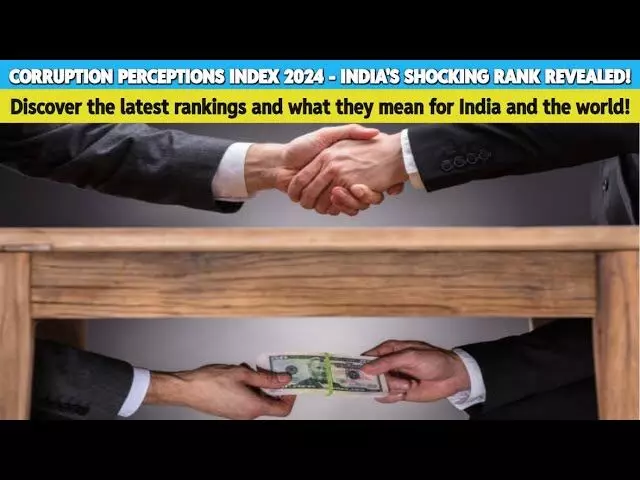Global Corruption Crisis: India’s Decline and the Unsettling Trends in 2024

The latest Corruption Perceptions Index (CPI) for 2024, released by Transparency International, highlights a grim reality for nations struggling with corruption. Denmark has once again secured the top spot as the least corrupt country, followed closely by Finland, Singapore, and New Zealand. These nations continue to set an example with their strong institutions, transparent governance, and robust anti-corruption laws. However, the report also reveals some disturbing trends—India has fallen three spots to 96th place, marking a continuous decline from previous years. The CPI score, based on expert and business perceptions of corruption in the public sector, underscores an alarming pattern worldwide.
India’s CPI score has fallen from 40 in 2022 to 39 in 2023, and further down to 38 in 2024. This decline is not merely a numerical drop but signifies deeper governance and systemic issues. India now ranks 96th among 180 countries, slipping further in global perception despite multiple government promises to tackle corruption. This raises the question—why is India struggling to improve its ranking despite stringent anti-corruption laws and initiatives?
When compared to its neighbors, India’s performance is still better than Pakistan (135th), Sri Lanka (121st), and Bangladesh (149th), but it lags behind China, which is ranked 76th. This comparison should serve as a wake-up call, especially as China has implemented strict anti-corruption measures under President Xi Jinping’s administration. The persistence of corruption in India, despite high-profile crackdowns, suggests that systemic loopholes and lack of enforcement remain a challenge.
Transparency International’s findings highlight a disturbing global trend—corruption levels remain alarmingly high, with efforts to curb them stagnating. The report notes that while 32 countries have made significant progress in reducing corruption since 2012, 148 nations have either remained stagnant or worsened. This indicates that global corruption is not just persisting but, in many cases, growing stronger.
One of the most alarming revelations is that nearly 85% of the world’s population now lives in countries where corruption levels have either remained unchanged or worsened in the past decade. In contrast, only 15% of the global population resides in nations where corruption has declined significantly. This raises questions about the effectiveness of anti-corruption mechanisms worldwide and whether political willpower is truly committed to tackling this pervasive issue.
Denmark, Finland, and New Zealand have maintained their top rankings due to their strong institutions, accountability frameworks, and public trust in governance. These countries demonstrate that a low tolerance for corruption, effective law enforcement, and strong democratic institutions are key factors in keeping corruption at bay. Their governments ensure that law enforcement agencies operate independently, reducing political interference in corruption-related investigations.
In contrast, countries ranking low on the CPI, including India, struggle with factors such as lack of judicial independence, weak enforcement of laws, bureaucratic inefficiency, and opaque political funding. This disparity between top-performing and poorly ranked nations underscores that corruption is not merely a function of wealth but of governance quality.
One of the biggest challenges India faces in reducing corruption is political interference. The electoral bond scheme, which has been heavily criticized for lacking transparency, has allowed anonymous corporate funding to political parties, making it difficult to track illicit financial flows. This has created a system where political patronage dictates governance, reducing accountability and fueling corruption.
Additionally, the bureaucracy in India remains plagued with inefficiencies and red tape. The ease of doing business is often compromised by bribery demands at multiple levels, from obtaining licenses to securing government contracts. Corruption is so deeply entrenched in administrative processes that even well-intentioned policies face significant roadblocks due to corrupt practices at the implementation level.
Corruption is not just a governance issue; it has massive economic implications. Studies suggest that corruption can reduce a country’s GDP growth by 1-2% annually, as resources meant for public welfare are siphoned off through corrupt practices. In India, corruption contributes to income inequality, weakens investor confidence, and increases the cost of essential services for ordinary citizens.
According to a World Bank report, nearly 40% of funds allocated for public welfare programs in India are lost due to corruption and inefficiencies. This means that a significant portion of taxpayer money meant for education, healthcare, and infrastructure is wasted, depriving millions of people of their rightful benefits.
For India to improve its CPI ranking and tackle corruption effectively, systemic reforms are necessary:
1. Judicial Independence – Strengthening the independence of anti-corruption bodies like the Central Vigilance Commission (CVC) and the Lokpal will be crucial.
2. Transparency in Political Funding – Scrapping opaque funding mechanisms such as electoral bonds and enforcing strict disclosure norms for political donations.
3. Digitization and Automation – Expanding the use of technology in governance to reduce bureaucratic discretion and human intervention, thereby minimizing opportunities for bribery.
4. Whistleblower Protection – Strengthening laws to protect whistleblowers and ensure that those exposing corruption are not targeted or silenced.
5. Strict Enforcement of Laws – Ensuring that high-profile corruption cases are prosecuted swiftly and fairly, setting a precedent that corruption will not be tolerated.
India’s slip in the global corruption index is not just a matter of perception but a reflection of deeper systemic failures. While the country has taken steps toward digital governance and anti-corruption measures, much remains to be done. The political class must show genuine intent in tackling corruption instead of using it as a tool for selective targeting. The question remains: Will India’s leadership rise to the challenge, or will corruption continue to erode its democratic institutions and economic progress? The coming years will determine whether India can break free from this cycle and reclaim its place as a nation with strong governance and transparency.
